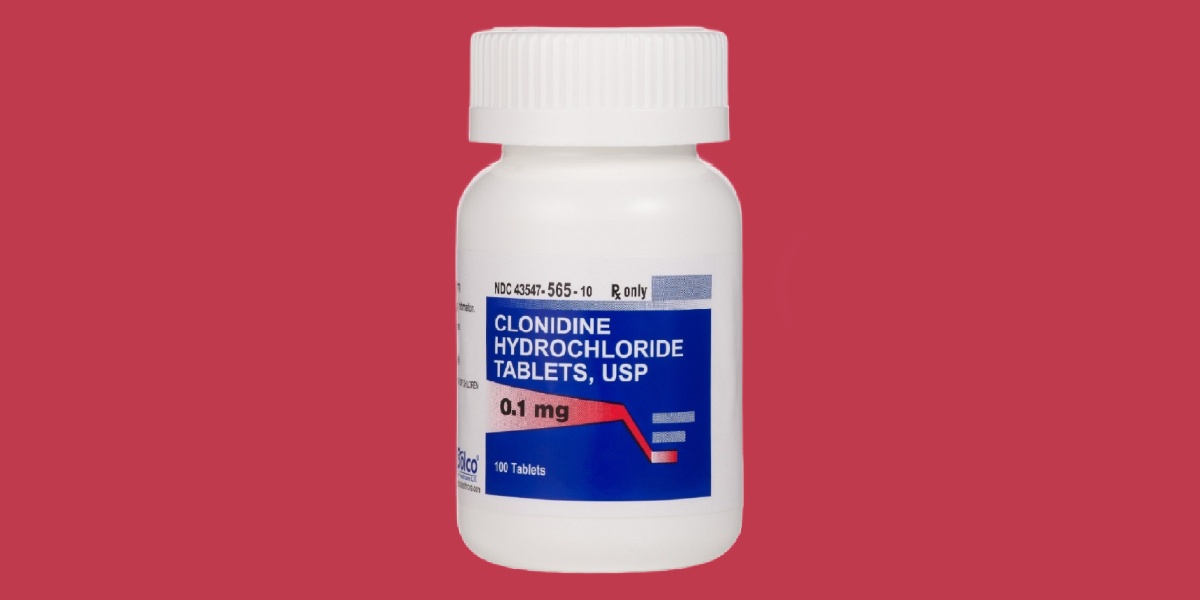Clonidine is a vasodilator, used to reduce blood pressure. It has many medicinal uses and can be an effective treatment in the management of opioid withdrawal symptoms. Clonidine can cause side effects, such as sedation and low blood pressure. It should be used only when prescribed by a medical professional.

What is clonidine?
Clonidine is a centrally acting alpha-agonist hypotensive agent, also called a vasodilator, which reduces blood pressure. It is available as an immediate-release tablet, extended-release tablet, and transdermal patch, and has various medicinal uses. [1][2]
Generic clonidine is available, as well as brand-name versions including: [1][3][4]
- Catapres: Immediate-release tablets in 0.1mg, 0.2mg, and 0.3mg strengths
- Kapvay: Extended-release tablets in 0.1mg and 0.2mg strengths
- Catapres-TTS: Transdermal patch in 0.1mg, 0.2mg, and 0.3mg strengths
Depending on the purpose of use, a typical daily dose of clonidine for adults is between 0.2mg and 0.6mg, usually administered in divided doses.
How does clonidine work?
Clonidine stimulates receptors in the brain called alpha-adrenoreceptors, causing central nervous system sympathetic outflow to be reduced and inhibiting cardiovascular neurons. This means that the arteries become relaxed and widened, improving blood flow to the heart, thereby reducing blood pressure and heart rate. [2][5]
Its impact on the sympathetic nervous system also results in other effects, such as reduced epinephrine circulation. This range of effects allows clonidine to be effective in the treatment of several different conditions. [5]
What is clonidine used for?
Clonidine is approved by the US Food & Drug Administration (FDA) for the following uses: [1][5]
- Hypertension (high blood pressure)
- Attention-deficit/hyperactivity disorder (ADHD)
- Managing tics associated with Tourette syndrome
- Cancer-related pain (as an adjunctive medication)
Clonidine is also used off-label for various purposes, including: [2][5]
- Withdrawal symptom management for opioid, benzodiazepine, and alcohol dependence
- Anxiety
- Insomnia
- Post-traumatic stress disorder (PTSD)
- Migraines
- Menopausal hot flushes
- Restless leg syndrome
Side effects of clonidine
Often, when starting a new medication, side effects can occur. Side effects of clonidine are typically mild and will be alleviated quickly. However, in some cases, side effects can be persistent or severe, in which case a doctor should be consulted immediately as it may be necessary to provide treatment or a change of medication. [6]
Common side effects of clonidine include: [1][2][5]
- Fatigue
- Drowsiness
- Weakness
- Headaches
- Nervousness
- Nausea
- Vomiting
- Constipation
- Diarrhea
- Stomach pain
- Dry mouth
- Sexual dysfunction
- Dizziness
- Low mood
- Insomnia
Severe side effects of clonidine can include: [2][6]
- Rash or hives
- Swelling of the face or mouth
- Swelling in the limbs
- Trouble breathing
- Irregular heartbeat or palpitations
- Low blood pressure
- Confusion
- Hallucinations
- Extreme mood changes
Precautions
Some risks and precautions to be mindful of when considering clonidine treatment include: [1][3]
- Clonidine may not be safe for individuals who have had a stroke, heart attack, heart or kidney issues, blood circulation issues, or peripheral neuropathy.
- Clonidine can cause extreme sedation and drowsiness, so it may not be safe to drive or operate machinery while taking this medication.
- People who are pregnant or breastfeeding should discuss their options with a doctor before starting clonidine treatment as there may be some risk of harm to the fetus or feeding infant.
- Older adults may be at increased risk of adverse effects from clonidine treatment, so they should be offered alternative medications.
- It is advised not to use clonidine with central nervous system depressants, such as alcohol, opioids, and benzodiazepines. This can cause an increased risk of harmful side effects such as extreme sedation, dizziness, reduced breathing rate, and confusion.
Contraindications
Some medications and substances can interact with clonidine and cause a reduction in the effects of the medication or an increased risk of side effects.
This includes other vasodilators, diuretics, beta-blockers, calcium channel blockers, mental health medications such as antidepressants, antipsychotics, and anxiolytics, Parkinson’s disease medications, tranquilizers and sedatives, muscle relaxants, NSAIDs, and methylphenidate (Ritalin). [1][6]
Always discuss current medications with the prescribing doctor before starting a new treatment.
Overdose
Clonidine can cause harmful effects if it is taken in larger doses than prescribed. Signs of a clonidine overdose include: [2]
- Severe reduction in heart rate
- Trouble breathing
- Difficulty with speech
- Extreme sedation
- Confusion
- Dizziness and fainting
In the event of a clonidine overdose, call 911 immediately.
Is lofexidine the same as clonidine?
Lofexidine is a structural analog of clonidine, which means that they are very similar substances, sharing similar chemical structures and effects. Unlike clonidine, lofexidine is FDA-approved for use in opioid withdrawal. Also, lofexidine is less likely to cause side effects such as low blood pressure or sedation than clonidine, so it can be a safer and more effective treatment. [7][8]
Clonidine for opioid use disorder detox treatment
Clonidine is often used off-label as a treatment for opioid use disorder detox, as it can help reduce some of the unpleasant withdrawal symptoms that occur during this process, including: [9]
- Vomiting
- Diarrhea
- Sweating
- Chills
- Anxiety
- Insomnia
- Shaking
- Stomach cramps
Clonidine is typically considered a safe and effective treatment for opioid detox. It can be a helpful treatment when opioid replacement therapy (such as methadone) is not effective or is inappropriate. Clonidine should not be used alongside opioid medications as this can result in dangerously low blood pressure. [8][9]
Clonidine is typically used for 7-14 days to aid in the withdrawal process. It can be beneficial during initial abstinence and detox, although it is often necessary to then commence maintenance medications and therapeutic interventions for long-term abstinence. As such, clonidine might be used following abrupt opioid discontinuation, prior to the commencement of naltrexone treatment. [8][9]
Does insurance cover clonidine treatment?
Clonidine treatment might be covered by some insurance plans, particularly if it is deemed necessary for treatment. However, this can vary depending on the plan, health insurance provider, healthcare provider, and other individual circumstances. It is recommended to contact your health insurance provider directly to determine what treatments are included in your plan.



-guide-detail.jpg?v=1756808727)
